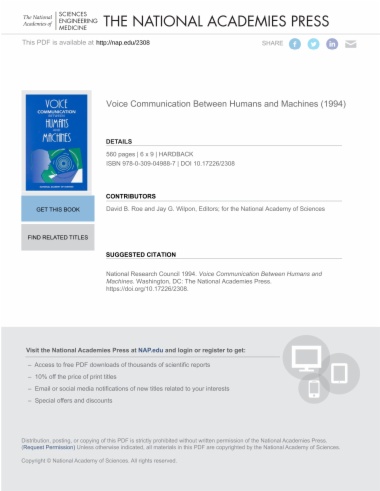Science fiction has long been populated with conversational computers and robots. Now, speech synthesis and recognition have matured to where a wide range of real-world applications—from serving people with disabilities to boosting the nation's competitiveness—are within our grasp.
Voice Communication Between Humans and Machines takes the first interdisciplinary look at what we know about voice processing, where our technologies stand, and what the future may hold for this fascinating field. The volume integrates theoretical, technical, and practical views from world-class experts at leading research centers around the world, reporting on the scientific bases behind human-machine voice communication, the state of the art in computerization, and progress in user friendliness. It offers an up-to-date treatment of technological progress in key areas: speech synthesis, speech recognition, and natural language understanding.
The book also explores the emergence of the voice processing industry and specific opportunities in telecommunications and other businesses, in military and government operations, and in assistance for the disabled. It outlines, as well, practical issues and research questions that must be resolved if machines are to become fellow problem-solvers along with humans.
Voice Communication Between Humans and Machines provides a comprehensive understanding of the field of voice processing for engineers, researchers, and business executives, as well as speech and hearing specialists, advocates for people with disabilities, faculty and students, and interested individuals.
- Cover
- Front Matter
- Dedication
- Voice Communication Between Humans and Machines--An Introduction
- Scientific Bases of Human-Machine Communication by Voice
- Scientific Bases of Human-Machine Communication by Voice
- The Role of Voice in Human-Machine Communication
- Speech Communication -- An Overview
- Speech Synthesis Technology
- Computer Speech Synthesis: Its Status and Prospects
- Models of Speech Synthesis
- Linguistic Aspects of Speech Synthesis
- Speech Recognition Technology
- Speech Recognition Technology: A Critique
- State of the Art in Continuous Speech Recognition
- Training and Search Methods for Speech Recognition
- Natural Language Understanding Technology
- The Roles of Language Processing in a Spoken Language Interface
- Models of Natural Language Understanding
- Integration of Speech with Natural Language Understanding
- Applications of Voice-Processing Technology I
- A Perspective on Early Commercial Applications of Voice-Processing Technology for Telecommunications and Aids for the Handicapped
- Applications of Voice-Processing Technology in Telecommunications
- Speech Processing for Physical and Sensory Disabilities
- Applications of Voice-Processing Technology II
- Commercial Applications of Speech Interface Technology: An Industry at the Threshold
- Military and Government Applications of Human-Machine Communication by Voice
- Technology Deployment
- Deployment of Human-Machine Dialogue Systems
- What Does Voice-Processing Technology Support Today?
- User Interfaces for Voice Applications
- Technology in 2001
- Speech Technology in the Year 2001
- Toward the Ultimate Synthesis/Recognition System
- Speech Technology in 2001: New Research Directions
- New Trends in Natural Language Processing: Statistical Natural Language Processing
- The Future of Voice-Processing Technology in the World of Computers and Communications
- Author Biographies
- Index

